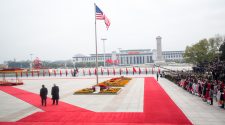A B-52 bomber carrying the ARRW.
AFA 2020: Lockheed Martin’s air-launched hypersonic missile will complete its critical design review (CDR) today, as the company and the Air Force press ahead on development, John Varley, vice president for hypersonic weapons at Lockheed Martin, says.
The company’s first contract for the Air Force’s AGM-183 Air-Launched Rapid Response Weapon (ARRW), inked in 2018, was set at $480 million for concept development. In December 2019, it nabbed another contract, worth $998 million, to bring its concept to CDR.
However, as reported by colleague John Tirpak, the service is expected to toss more development funding into the ARRW program after cancelling the second hypersonic missile program, the Hypersonic Conventional Strike Weapon (HCSW). Lockheed Martin Space had received a $928 contract in April 2018 for design work on HCSW.
In fact, all of the company’s ongoing hypersonic design programs will go through a design review or tests during the next 12 to 24 months, Varley told reporters yesterday following a tour of the Lockheed missile and fire controls factory here in Orlando.
Lockheed Martin’s hypersonic business is currently worth about $3.5 billion, according to the company, with programs underway for the Army, Navy and Air Force, as well as DARPA.
For DARPA, the firm is working on the Tactical Boost Glide (TBG) project to flight test technologies to enable a “tactical range” air-launched hypersonic missile — technologies intended to feed into the ARRW. DARPA granted a $147.3 million contract to Lockheed Martin in 2016 for the program; competitor Raytheon was awarded a TBG concept maturation contract for $63.3 million in 2019.
Asked about why ARRW is going through CDR before technologies have been flight tested under the TBG program, Varley provided few details — citing the “high-level sensitivities” surrounding TBG. He would only say that the two programs at one time “were more serial; now they are more parallel.”
Lockheed Martin is looking to design missiles that can fly at Mach 10, twice the Mach 5 threshold speed for what is considered a hypersonic missile. Varley admits that will be hard to achieve.
“We have a lot of challenges,” he said. One key problem is building a missile and subcomponents, such as communications gear, able to withstand the 4,000 degree Fahrenheit temperatures built up by that kind of speed. This means the US needs to develop innovative, heat-resistant materials as a foundational matter, he said. Other problems include maintaining maneuverability and accuracy, as well as sustaining communications connectivity with operators as the missile speeds along.
Besides working on air-launched hypersonic missiles, Lockheed Martin in August 2019 won a $347 million contract to integrate the so-called Common Hypersonic Glide Bodies with guidance systems, rocket boosters, and protective canisters etc. into the Army’s ground-launched Long Range Hypersonic Weapon (LRHW) launchers. The contract is part of the Army’s effort to rapidly field LRHW prototypes.
The Common Hypersonic Glide Bodies are being built by Dynetics for the Army and Navy under a $351.6 million Army contract.
Lockheed Martin is also working with DARPA on the Operational Fires (OpFires) mobile ground-launched hypersonic missile, winning a $31.9 million contract for the Phase 3 Weapon System Integration program in January.
Lockheed Martin is working on design of what it calls a new Hypersonic Strike Weapon-Air Breathing (which goes by the awful acronym HSW-ab) for DARPA. Varley wouldn’t provide details due to the program’s high level of classification.


















